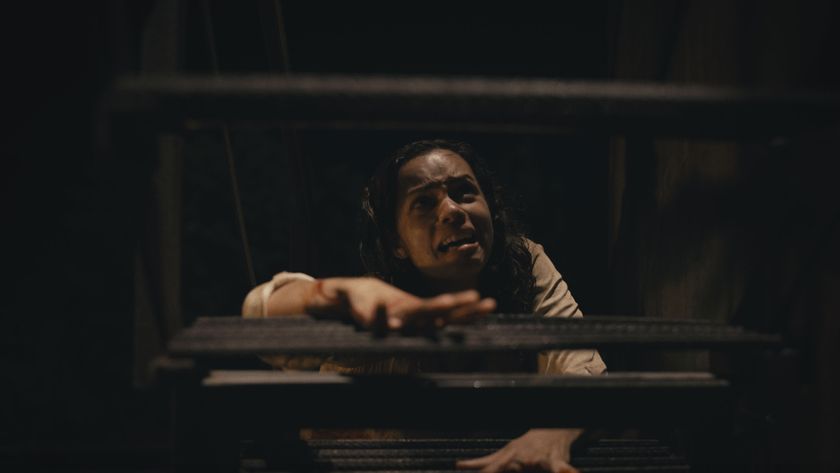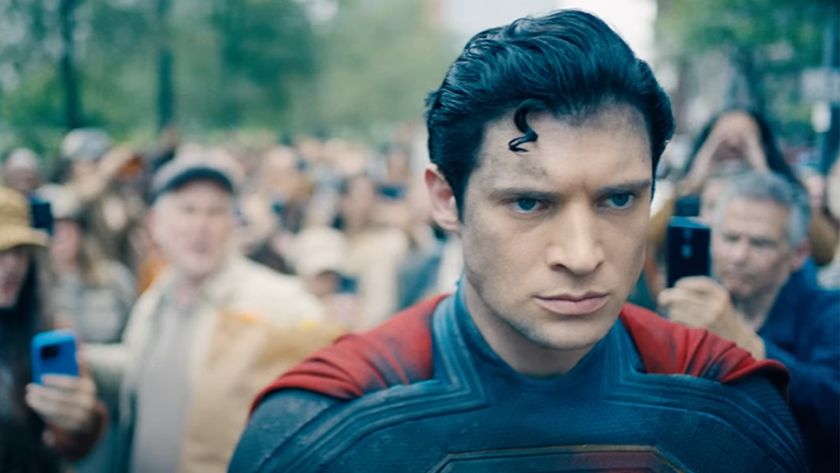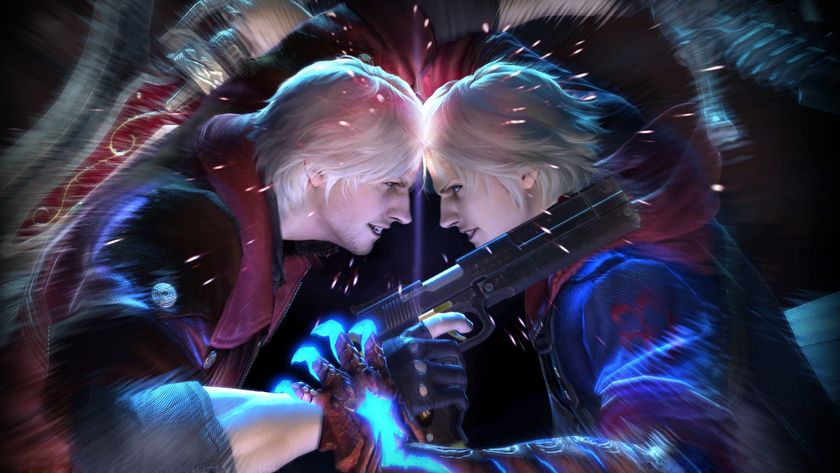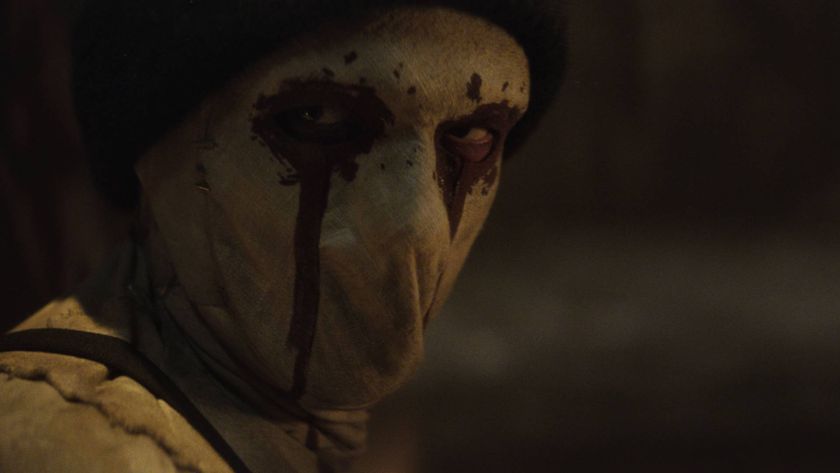The Story Behind The Blind Side
What happened before the accolades and the awards...
A Golden Globe. A Screen Actors Guild Award. And finally, triumphantly, an Oscar.
That’s the soaring, seat-of-her-pants thrill ride that directed Sandra Bullock to award-hogging glory this year. The film? Some football flick called The Blind Side .
Um, blind what? Yeah, in yet another case of release date nuisance, those folks in the US kept nominating and awarding an actress for a film that we Brits hadn’t even heard of yet, let alone seen. And a sports movie, at that.
Now, on 26 March (the same week that The Blind Side hits DVD shelves Stateside), we will finally get to see what all the fuss has been about. How does a loveable rom-com actress go from dreck like All About Steve to Oscar glory in the space of just a few swift months?
It’s a question that was asked previously in 2005, when sudsy screen lovely Reese Witherspoon nabbed herself an Academy Award for Walk The Line . Well, now we’re going to ask it again as we track the making of the flick that awarded an Oscar to a Comedy Queen.
Says Ms Bullock herself: “Everything that's happened this year wasn't planned. None of this was on the calendar.
"I just like to work. I don't usually get accolades, as you can see from a lot of my work. It's been a big year in a way I haven't gotten used to yet...”
Sign up for the Total Film Newsletter
Bringing all the latest movie news, features, and reviews to your inbox
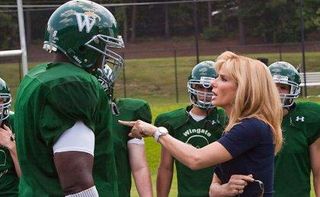
Next: The Blind Side [page-break]
The Blind Side
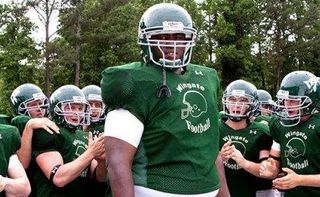
First, let’s get the obvious out of the way: what exactly is a blind side? Hint – it’s somewhat related to a car’s so-called blind spot, whereby a certain area (generally just over the shoulder of the driver) is hard to check while manoeuvring, and therefore considered ‘blind’ to the driver.
In American Football, it means something else entirely. According to a few handy websites , the blind side is “the side of the field opposite to the way a player is facing. This term is often used when describing offensive tackles.
“The left tackle is often said to be protecting the quarterback's blind side. Since most quarterbacks are right handed, they fall back facing the right side of the field, thus the importance of a strong left tackle to protect them from defenders hitting them from behind or the blind side.”
Right. Got it. (Sort of.) But... what does footie jargon have to do with a drama starring Sandra Bullock?
Well, it all starts, as is often the case, with tragedy.
Michael Jermone Oher is one of the greatest American football players ever, sweating it out on the pitch for the National Football League (NFL) to a decent slab of money. But he came this close to never making it out of the chains of his choking youth.
Born in 1986, one of 12 children parented by a crack cocaine addicted mother and a jail mate father, Michael Oher’s formative years were devoid of love and nurture. In his first nine years as a student he attended 11 different schools, and had to repeat both first and second grade.
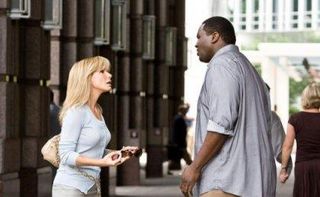
At that time, he was ushered from foster home to the streets of New Orleans and back again, spending many of the years leading up to his sixteenth birthday homeless. His father Michael Williams was murdered when Michael junior was still in high school.
But Father Fate had big ideas for Michael Oher, and when he was 15-years-old, chance smiled on him. A firecracker mother-cum-interior-designer called Leigh Anne Tuohy spotted Michael wandering the streets on a freezing Thanksgiving night, and took him into her family home.
No small gesture, considering the Tuohy’s were a wealthy, white, middle-upper-class family, the polar opposite of a towering black inhabitant of the appropriately-named Hurt Village, who didn’t have two pennies to rub together.
Leigh Anne and husband Sean owned (and continue to own) over 80 Taco Bell, KFC and Long John Silver restaurants, meaning that their affluent, comfortable lifestyle was a shock in comparison to Michael’s destitute upbringing.
But this didn’t have any bearing on the spirited Leigh Anne, who saw a child in need of help, and didn’t hesitate in reaching out a hand.
In the space of a couple of years, Michael was adopted into the Tuohy family, found his calling as a football player, gained decent grades, and got himself a place at the University of Mississippi.
“I am telling you there are Michael Ohers everywhere,” says Leigh Anne. “Wonderful kids who need a home, who want a family. It doesn’t take much searching out because they are right under your nose.
“And they don’t need to be brilliant at football. They don’t need to be someone who excels at anything other than loving you and wanting love in return.”
Next: Evolution Of A Game [page-break]
Evolution Of A Game
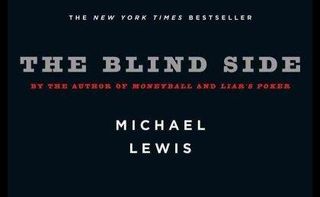
Writer Michael Lewis came across the story of the Tuohys and Michael by accident. He was writing an article about his old baseball coach, and phoned former school buddy Sean Tuohy to grab some quotes for the piece. In due course, Lewis met Michael and discovered the story behind his induction into the Tuohy clan.
“When Michael Lewis first called, he was going to write a nice, little article,” laughs Sean. “We still haven’t quite figured out how, somewhere along the way in this whole thing, it went from a nice little article to a book and now a movie.”
Lewis knows. He was so startled by Michael’s story, a true example of triumphing over phenomenal odds, that he wanted to turn it into a novel.
“If you didn’t tell this story, people might assume that Michael Oher was just this great athlete and he was predestined to be in the NFL,” Lewis reasons.
“But when you look more closely, you see that if he hadn’t gotten out of that environment, he wouldn’t have even made it on a high school football field, let alone college of the NFL. He would have been dead or in jail... or just forgotten.”
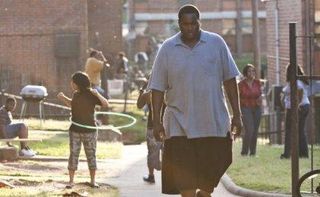
The resultant book was entitled The Blind Side: Evolution Of A Game , and twinned Michael’s remarkable tale with an examination of how the left tackle has become one of the most important – and highly paid – positions in American football.
It wasn’t long before John Lee Hancock, who had directed Charlie Sheen in The Rookie and Dennis Quaid in The Alamo , discovered the book and set about adapting it into a script.
“It really is two different stories,” says the director. “One of which is more of a question: Who is Michael Oher and why did the stars align to shine so brightly on this kid from the projects in Memphis?
“And then on the other side, it’s a great story about how this unique family evolved, and the unconventional mother-son relationship at its centre.
“Sports, specifically football, was the engine that propelled the story forward, but he could have been a dancer or a pianist – it wouldn’t have made any difference. The journey that Michael and the Tuohy family go on is the heart of the movie.”
Actor Tim McGraw, who plays papa bear Sean in the film, agrees: “Whether or not you are interested in football, or sports at all, the story behind this movie so heart-warming, I think it will appeal to everyone.”
Next: Oh Sandy... [page-break]
Oh Sandy...
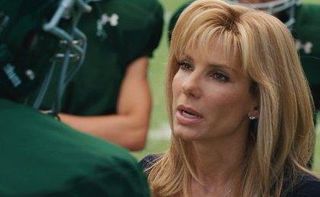
The biggest obstacle now facing the fledgling production was: who could possibly bring spitfire Leigh Anne to suitably vivacious life?
With the part having been turned down by Julia Roberts, given a first look at the screenplay, Hancock approached another big-name, big-screen actress who seemed to fit the bill.
“It was a beautifully written script,” says Sandra Bullock. “It had all the right beats in all the right places. And I was amazed how John gave every one of the characters such a nice arc... each character has a distinct journey.”
But that didn’t stop her turning the part down three times.
“Sandy liked the script but was having trouble figuring out how to portray Leigh Anne,” explains Hancock. “We would meet and she would ask all kinds of questions, but I wasn’t able to come up with the answer she was looking for.
“I think Sandy was understandably frustrated with my inability to describe the character, but that’s because Leigh Anne is indescribable.”
Eventually, he and Bullock went to visit Leigh Anne, and the actress spent a whole day with the working mother and all that went with it (“craziness, mayhem, fun, laughter and getting a lot of stuff done in very short order,” according to Hancock).
Only when Bullock met Leigh Anne was she able to fully understand why her director was finding it so difficult to boil her down to so many adjectives and characteristics.

“You don’t meet an energy like Leigh Anne’s ever," Bullock assures us. "I felt a great sense of fear in trying to tackle that person she is, but also a great sense of obligation to be true to this wonderful dynamic.
“John could not explain Leigh Ann to save his life, and when I met Leigh Anne, I said, ‘Now I know why you can’t, because she’s original.’ But there’s such a dynamic that exists between those people and their children that you wanted to pay homage to them. I wanted to do it as closely as I could, so I did my best.
“She doesn’t care what it takes; she just gets it done her way. All I can say is, if there were more Leigh Anne Tuohys, the world would be a better-run, more harmonious and more productive place... as long as it was by her rules.”
In preparation for the movie, the Tuohy’s “opened up their home and their lives” to the cast and crew, instilling a great sense of duty in those who would eventually portray them on-screen.
For Bullock, that mostly meant perfecting Leigh Anne’s accent.
“Many people think a Southern accent is a Southern accent, but there are many different ones,” says the actress.
“But it wasn’t just Leigh Anne’s accent. My dialect coach explained it was also the intent behind her words. I wasn’t trying to copy her exactly because then it becomes a caricature, but there is a way she goes about life that you need to pick up on or you’re going to be left behind.”
Leigh Anne, on the other hand, received many a late-night phone call from the frantic actress, who was almost pernicious in her plight to get Leigh Anne right.
“She hounded me,” the real Leigh Anne laughs. “She called me and said, ‘Say Leigh Anne 30 times. Say Sean.’ There were words she’d want me to go over and over, and I’m thinking ‘Didn’t you get it the first dozen times?’ She was very persistent, but she did a good job.”
Next: Casting Michael [page-break]
Casting Michael
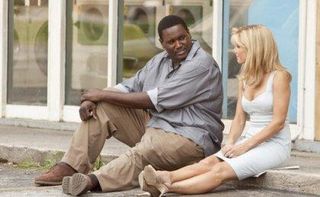
With their leading lady locked down, it was time for Hancock and his team of producers to seek out their gentle giant.
The process of casting Michael Oher was a long, drawn-out, exhausting one that Hancock likens to looking for “a needle in a haystack”. Their search for an individual who was both physically and spiritually an embodiment of everything that Oher was proved to be a massive challenge.
Trawling through states and books of head shots, Hancock finally came across the tape of a young actor called Quinton Aaron.
“When I saw Quinton’s tape, there was something about him that was missing in the other ones,” says Hancock. “Then when he came in the door, my first instinct was to hug him, and it was that quality that first struck me.
“He also has a face that draws you in; when he’s quiet and looks at you with those doe eyes, there’s a story there that you want to know. I just had a gut feeling he was our guy... that we were about to change his life in a spectacular way.”
For Quinton, it “was better than any dream”. The then-24-year-old actor had made appearances in Law & Order and Gondry’s Be Kind Rewind , but was working as a security guard to make ends meet between acting jobs.
After his audition, he left a card behind offering his services as a security guard on the film if he didn’t get the part. He had never been given an opportunity like this. But, to him, the role made perfect sense.
“When I read the story, I saw that we had a lot in common,” the actor says. “Neither of us knew our fathers growing up. I was the biggest kid in my school; he was the biggest kid in his school.
“I wanted to be a part of bringing his story to light, because it’s the story that will inspire a lot of our youth today, I feel, because it tells you that basically no matter how hard of a background you come from, you don’t have to turn to guns and violence and end up in jail or the morgue, just because of how bad you had it.
“Everyone goes through things but they’ve got to know that it’s not going to last forever, and there’s a way out. That’s what I got from this.”
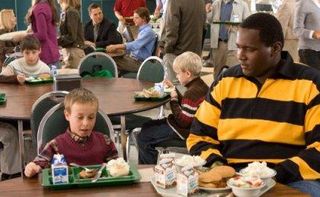
Attempting to make him look believable on the football pitch, though, was another matter. Quinton had played some football in high school – unfortunately, he wasn’t very good.
So it was to the trainer with him.
“We got him involved with trainers, who set him up with a regimen of diet and workouts,” says Hancock. “He lost a lot of weight, but, more importantly, he started to look like an athlete.”
Quinton went at it with nothing short of youthful exuberance. “I was determined to do anything and everything required, because if you love what you’re doing, you are going to give one hundred and ten percent.
“Before the movie started I went through seven weeks of intense training, with two-a-day practices every day and we continued training through filming.
“I started calling John Lee Hancock ‘Coach Lee’ because he was always encouraging me and making me feel good about everything I was doing. It was so much fun; I loved every minute of it.”
For Sean Tuohy, it was especially important that Michael’s message be carried through the film.
“Michael was once completely devalued in the world. Imagine what kind of value we put on kids like him who don’t happen to be athletic. Imagine who gets passed by and that’s a shame. I think this story says we need to do more to help kids, all of whom have value.”
Next: The Tuohys [page-break]
The Tuohys
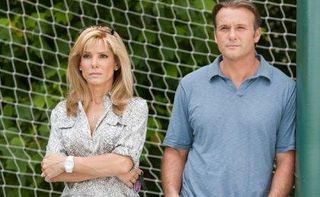
Behind every strong woman there’s a man stabbing her in the back, goes the saying.
Not so with the Tuohys. Where Leigh Anne is very much the ‘pusher’ of the family - getting jobs done, organising, co-ordinating and synchronising schedules - it was important her movie husband not get lost in the whirlwind.
Says producer Broderick Johnson:
“We needed an actor who would have a real screen presence opposite the whirlwind that is Leigh Anne. We had to have an actor who would make Sean feel as important as she without having as much screen time.”
Hancock agreed: “When you’re around the Tuohy family, you get the sense that she’s the engine, but he is the glue that holds it all together. Sean is completely self-assured and comfortable in his own skin. He has that Southern ex-athlete attitude; there’s a swagger there.”
A number of actors were tested out, but in the end it was country singer Tim McGraw who best suited the role. Not only because of his acting ability, but because his life so obviously echoed that of fellow Louisiana native Sean.
“I was always an athlete; I can’t remember ever not playing sports,” McGraw recalls. “I thought that’s what I was going to do with my life... Until I got to college and bought a guitar. And the rest is history.”
His take on Sean and his significance within the family unit is simple but bang on the money.
“Sean is an all-round good guy, and the inspirational story of what he and his family did for this kid – the time, the effort and the love he put out – is pretty incredible,” says McGraw.
“Also, a positive movie about sports is something I really enjoy seeing because sports, if played the right way and coached the right way, can really teach you a lot about yourself and about life in general.”
For the rest of the family – teenage daughter Collins and 10-year-old energy-stuffed son SJ – the producers looked to bit-part TV actors who were relatively new to the media scene.
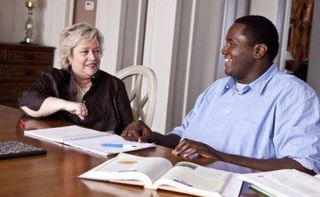
Fittingly, Lily Collins won the role of Collins. Having guest starred on just 90210 , The Blind Side provided a big opportunity and challenge for her: forging a family unit with relative strangers. Hey, no problem...
“We were all learning together and sharing new experiences, which made it really fun,” Collins remembers.
“From the very beginning, we were like real siblings. Quinton took me under his wing and called himself my bodyguard; he was a big, gentle teddy bear, which is apparently the same relationship Collins had with Michael.
“And Jae! The moment we met, we started going back and forth and nagging each other like only a little brother and big sister can do."
Diminutive Friday Night Lights and Law & Order guest actor Jae Head nabbed the role of SJ – something he says is “really cool”.
Meanwhile, Kathy Bates was drafted to play Miss Sue, the inspirational home tutor who helped Michael to catch up on all of the school that he had missed out on.
For the real Miss Sue, there was no other choice for her big screen counterpart: “I think she was the perfect person to play me; it was a true honour.”
“Miss Sue and I didn’t meet but had a long talk on the telephone,” says Bates.
“It turns out she and I grew up very close to one another. It was a great help to listen to her voice and her stories about Michael. I was very moved by it and by the fact that it was true and still in motion. It’s current, it’s true, and it shows the power of the golden rule in action.”
Next: Building Lives [page-break]
Building Lives
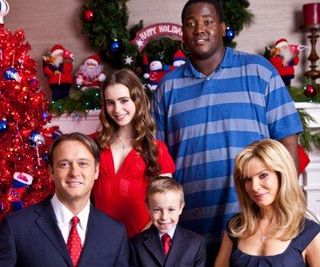
As Bullock set about crafting her own version of Leigh Anne – dying her brunette locks blonde and working with dialect coach Francie Brown – focus shifted to creating the world that the characters would inhabit.
Executive Producer Timothy M Bourne was keen to shoot in a place that stayed true to the film’s New Orleans location.
“There is a similarity between most Southern cities, and Atlanta is not too far away from Memphis, geographically or emotionally,” he says. “It’s also a great place to shoot. There is a huge crew base there and they have a terrific infrastructure. There are so many advantages and the people are wonderful. You can’t beat it.”
In designing the look of the film, production designer Michael Corenblith drew on photographs by William Eggleston. Which turned out to be a fortuitous decision: he and the film's cinematographer both turned up to a meeting with the same book of Eggleston’s work.
The Tuohy’s house, meanwhile, was based on the family’s real home. “Leigh Anne was phenomenally gracious and opened her home to our set decorator Susan Benjamin,” says Corenblith. “Susan spent two days with the family, which allowed us to emulate Leigh Anne’s decorating style.”
A final piece of good fortune came when location scouts happened upon a large housing project that was soon to be ripped to pieces – the perfect place to recreate Hurt Village, the place where Michael spent his formative years.
“It was, for the most part, empty,” recalls Corenblith. “It had the size and scale of the actual Hurt Village, and it represented the polar opposite of the neighbourhood where the Tuohy family lived.
“The direct contrast between these two worlds became a way of personifying Michael’s journey, which, as a designer, is the clearest way I know to tell the story.”
Next: What Came Next... [page-break]
What Came Next...
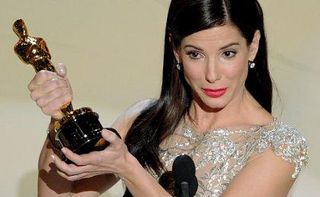
“For anyone who wants to interpret the whole thing as some kind of miracle, there’s a lot of evidence,” says author Michael Lewis.
Made on a budget of just $29m, The Blind Side opened to the trill of $34m Stateside, and has now grossed a whopping $250m. Which makes it a huge financial coup for all involved.
It’s a warm hug of a movie, Bullock’s performance the obvious stand-out - though it’s still an odd choice for all the awards that she has garnered.
Hancock also dodges many of the tougher issues by bathing his film in glossy, straight-laced drama shades. But there’s no denying it’s a well-crafted pic full of heart. So how about them awards, eh Bullock?
In her Oscar’s speech, she was as humble and graceful as you’d expect. “I have so many people to thank for my good fortune in this lifetime. Everyone who’s shown me kindness when it wasn’t fashionable, I thank you.”
Producer Andrew A Kosove attributes the film’s massive success to its very modern concerns.
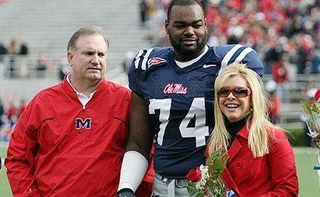
“It is a current events story, as it were, but I don’t think that creates complications as much as it creates opportunities,” he says. “It’s very timely, especially in the 21st century, when we have come to understand that there is no set type of family.
“We live in a society made up of different kinds of families, where the only things that really matter are out love and support for one another. I think that’s a wonderful thing, and it’s a message that people can really relate to in this day and age.”
Last word goes to Bullock... “It’s really made me satisfied in a way that I wasn’t looking for, but I was blessed with it and now I feel really full, in a good way, where I don’t need to rush out and go find something. I don’t want to.
“The Tuohy’s certainly did a good deed in taking in this young man in such a loving and generous way.
“But, in turn, he brought out a side of their family that they didn’t even realise was missing. The family seemed to have all the success and joy in the world, but when Michael showed up, it was as if he was the final piece to the puzzle.”
Like This? Then try...
Sign up for our free weekly newsletter here .
Follow us on Twitter here .
Josh Winning has worn a lot of hats over the years. Contributing Editor at Total Film, writer for SFX, and senior film writer at the Radio Times. Josh has also penned a novel about mysteries and monsters, is the co-host of a movie podcast, and has a library of pretty phenomenal stories from visiting some of the biggest TV and film sets in the world. He would also like you to know that he "lives for cat videos..." Don't we all, Josh. Don't we all.
